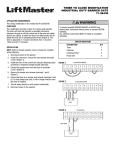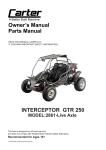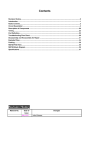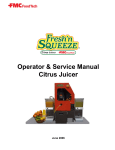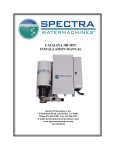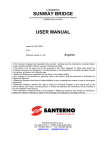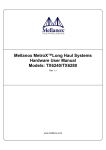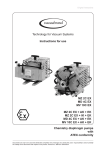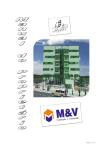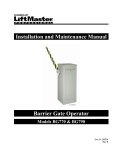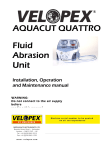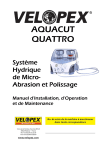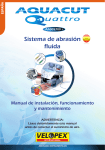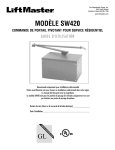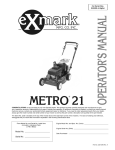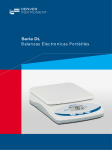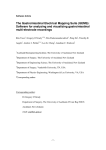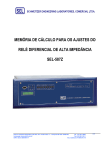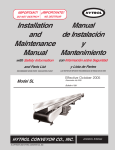Download BG770 & BG790
Transcript
The Chamberlain Group, Inc. 845 Larch Avenue Elmhurst, Illinois 60126-1196 www.liftmaster.com BG770 & BG790 INDUSTRIAL-DUTY BARRIER GATE OPERATOR OWN E R ' S M AN UAL MODELS BG770 AND BG790 ARE FOR VEHICULAR PASSAGE GATES ONLY AND ARE NOT INTENDED FOR PEDESTRIAN PASSAGE GATE USE TABLE OF CONTENTS SPECIFICATIONS IMPORTANT NOTES Operator Specifications. . . . . . . . . . . . . . . . . . . . . . . . . . . . . . . . . 3 Operator Dimensions . . . . . . . . . . . . . . . . . . . . . . . . . . . . . . . . . .3 • BEFORE attempting to install, operate or maintain the operator, you MUST read and fully understand this manual and follow ALL safety instructions. • These instructions are intended to highlight certain safety related issues. These instructions are not intended to be comprehensive. Because each application is unique, it is the responsibility of the purchaser, designer, installer and end user to ensure that the total gate system is safe for its intended use OPERATOR WARNINGS Safety Installation Information . . . . . . . . . . . . . . . . . . . . . . . . . . .4 PREPARATION Carton Inventory . . . . . . . . . . . . . . . . . . . . . . . . . . . . . . . . . . . . . . 5 Site Preparation . . . . . . . . . . . . . . . . . . . . . . . . . . . . . . . . . . . . . .5 Operation Preparation. . . . . . . . . . . . . . . . . . . . . . . . . . . . . . . . . . 5 INSTALLATION Pad Mounting . . . . . . . . . . . . . . . . . . . . . . . . . . . . . . . . . . . . . . . . 6 Arm Fabrication . . . . . . . . . . . . . . . . . . . . . . . . . . . . . . . . . . . . . .6 Calculate Arm Length . . . . . . . . . . . . . . . . . . . . . . . . . . . . . . . . . .6 Wiring Specifications . . . . . . . . . . . . . . . . . . . . . . . . . . . . . . . . . .7 Wiring Connections . . . . . . . . . . . . . . . . . . . . . . . . . . . . . . . . . . .7 Arm Attachment . . . . . . . . . . . . . . . . . . . . . . . . . . . . . . . . . . . . 8-9 Arm and Turnbuckle Shaft Adjustments . . . . . . . . . . . . . . . . . . .10 Limit Switch Adjustments. . . . . . . . . . . . . . . . . . . . . . . . . . . . . . 11 WARNING Mechanical WARNING Electrical OPTIONAL ACCESSORIES Vehicle Detectors . . . . . . . . . . . . . . . . . . . . . . . . . . . . . . . . . . . .12 Radio Controls . . . . . . . . . . . . . . . . . . . . . . . . . . . . . . . . . . . . . .12 Card Readers, Keypads or Other. . . . . . . . . . . . . . . . . . . . . . . . . 12 Mounting Location . . . . . . . . . . . . . . . . . . . . . . . . . . . . . . . . . . .12 CAUTION When you see these Safety Symbols and Signal Words on the following pages, they will alert you to the possibility of SERIOUS INJURY or DEATH if you do not comply with the warnings that accompany them. The hazard may come from something mechanical or from electric shock. Read the warnings carefully. When you see this Signal Word on the following pages, it will alert you to the possibility of damage to your gate and/or the gate operator if you do not comply with the cautionary statements that accompany it. Read them carefully. OPERATING INSTRUCTIONS Electrical Operation. . . . . . . . . . . . . . . . . . . . . . . . . . . . . . . . . . . 13 Manual Operation . . . . . . . . . . . . . . . . . . . . . . . . . . . . . . . . . . . .13 TROUBLESHOOTING Power . . . . . . . . . . . . . . . . . . . . . . . . . . . . . . . . . . . . . . . . . . . . .14 Accessories. . . . . . . . . . . . . . . . . . . . . . . . . . . . . . . . . . . . . . . . . 14 Primary Voltage Circuit. . . . . . . . . . . . . . . . . . . . . . . . . . . . . . . . 15 Low Voltage Circuit. . . . . . . . . . . . . . . . . . . . . . . . . . . . . . . . . . . 15 General Reference Information . . . . . . . . . . . . . . . . . . . . . . . . . . 15 REPAIR PARTS Illustrated Parts - Model BG770 . . . . . . . . . . . . . . . . . . . . . . . . . 16 Repair Parts - Model BG770. . . . . . . . . . . . . . . . . . . . . . . . . . . . 17 Illustrated Parts - Model BG790 . . . . . . . . . . . . . . . . . . . . . . . . . 18 Repair Parts - Model BG790. . . . . . . . . . . . . . . . . . . . . . . . . . . . 19 MAINTENANCE Limited Bearing Lubrication . . . . . . . . . . . . . . . . . . . . . . . . . . . .20 Grease Turnbuckle . . . . . . . . . . . . . . . . . . . . . . . . . . . . . . . . . . .20 WIRING DIAGRAMS Single Phase Wiring Diagram . . . . . . . . . . . . . . . . . . . . . . . . . . . 21 Three Phase Wiring Diagram . . . . . . . . . . . . . . . . . . . . . . . . . . .22 Control Connection Diagram. . . . . . . . . . . . . . . . . . . . . . . . . . . . 23 WARRANTY POLICY AND SERVICE . . . . . . . . . . . . . . . . 24 2 SPECIFICATIONS MOTOR ELECTRICAL Squirrel cage induction type (3 phase) or capacitor start induction type (1 phase), continuous duty, 1725 RPM. Horsepower is designated by second suffix of operator part number. -50; 1/2 Horsepower OVERLOAD PROTECTION Automatic reset (3 phase operators) or manual reset (1 phase operators) thermal overload. ELECTRICAL BOX NEMA 1 general purpose painted steel enclosure, contains all motor control equipment. Enclosure removable from operator. POWER Line voltage is designated by third suffix of gate part number. For amp draw, see motor nameplate. -11; 115Vac, 1 Phase, 60Hz -21; 230Vac, 1 Phase, 60Hz -81; 208Vac, 1 Phase, 60Hz -83; 208Vac, 3 Phase, 60Hz -23; 230Vac, 3 Phase. 60Hz -43; 460Vac, 3 Phase, 60Hz -53; 575Vac, 3 Phase, 60Hz CONTROL CIRCUIT Class II, 24Vac LIMIT SWITCHES Adjustable, driven limit switches, operate in class II circuit. Not affected by removal of motor. POWER ON/OFF SWITCH Enclosed toggle switch, HP rated. OPERATION MECHANICAL Prewired terminal strip accepts field connection of any access control device with normally open (N.O.) output contact (most access control equipment) and when required, a separate OPEN/CLOSE pushbutton (provided). Plug-in connectors are included for addition of a loop detector to open and/or a loop detector to hold open (not provided). Activation of access device open button, or loop detector to open will raise gate. Gate will lower automatically unless hold open loop detector is activated or unless CLOSE button wiring has been made, in which case gate will remain open until CLOSE button is pushed. An optional timer will extend the time that the gate remains open. AUTO/MANUAL switch holds arm in vertical position. SPEED REDUCTION Wormgear-in-oil-bath, 60:1 ARM TYPE MODEL BG770: One piece type to 15' MODEL BG790: Counterweighted wishbone type to 24' ARM SPEED MODEL BG770: Opens in 4 seconds MODEL BG790: Opens in 11 seconds LUBRICATION Permanently lubricated bearings in motor. Low temperature gear oil normally never needs replacement. Gear oil is Mobil SHC 630 or equivalent. ENCLOSURE Weatherproof, heavy gauge, pregalvanized steel, powdercoat finish, top and side access covers with key lock. Model BG770 17" MOUNTING Pad mount Model BG790 17" Counterweighted Wishbone Arm 17" 22" 17" Up to 15' 35" 44" Up to 24' DIMENSIONS DIMENSIONS Typical Installation Typical Installation 3 44" 35" OPERATOR WARNINGS SAFETY INSTALLATION INFORMATION 1. Vehicular gate systems provide convenience and security. Gate systems are comprised of many component parts. The gate operator is only one component. Each gate system is specifically designed for an individual application. 2. Gate operating system designers, installers and users must take into account the possible hazards associated with each individual application. Improperly designed, installed or maintained systems can create risks for the user as well as the bystander. Gate systems design and installation must reduce public exposure to potential hazards. 3. A gate operator can create high levels of force in its function as a component part of a gate system. Therefore, safety features must be incorporated into every design. Specific safety features include: • Gate Edges • Guards for Exposed Rollers • Photoelectric Sensors • Screen Mesh • Vertical Posts • Instructional and Precautionary Signage 4. Install the gate operator only when: a. The operator is appropriate for the construction and the usage class of the gate. b. All openings of a horizontal slide gate are guarded or screened from the bottom of the gate to a minimum of 4' (1.2 m) above the ground to prevent a 2 1/4" (6 cm) diameter sphere from passing through the openings anywhere in the gate, and in that portion of the adjacent fence that the gate covers in the open position. c. All exposed pinch points are eliminated or guarded, and guarding is supplied for exposed rollers. 5. The operator is intended for installation only on gates used for vehicles. Pedestrians must be supplied with a separate access opening. The pedestrian access opening shall be designed to promote pedestrian usage. Locate the gate such that persons will not come in contact with the vehicular gate during the entire path of travel of the vehicular gate. 6. The gate must be installed in a location so that enough clearance is supplied between the gate and adjacent structures when opening and closing to reduce the risk of entrapment. Swinging gates shall not open into public access areas. 7. The gate must be properly installed and work freely in both directions prior to the installation of the gate operator. 8. Controls intended for user activation must be located at least six feet (6') away from any moving part of the gate and where the user is prevented from reaching over, under, around or through the gate to operate the controls. Outdoor or easily accessible controls shall have a security feature to prevent unauthorized use. 9. The Stop and/or Reset (if provided separately) must be located in the line-of-sight of the gate. Activation of the reset control shall not cause the operator to start. 10. A minimum of two (2) WARNING SIGNS shall be installed, one on each side of the gate where easily visible. 11. For a gate operator utilizing a non-contact sensor: a. Reference owner’s manual regarding placement of non-contact sensor for each type of application. b. Care shall be exercised to reduce the risk of nuisance tripping, such as when a vehicle trips the sensor while the gate is still moving. c. One or more non-contact sensors shall be located where the risk of entrapment or obstruction exists, such as the perimeter reachable by a moving gate or barrier. 12. For a gate operator utilizing a contact sensor such as an edge sensor: a. One or more contact sensors shall be located where the risk of entrapment or obstruction exists, such as at the leading edge, trailing edge and post mounted both inside and outside of a vehicular horizontal slide gate. b. One or more contact sensors shall be located at the bottom edge of a vehicular vertical lift gate. c. A hard wired contact sensor shall be located and its wiring arranged so the communication between the sensor and the gate operator is not subject to mechanical damage. d. A wireless contact sensor such as the one that transmits radio frequency (RF) signals to the gate operator for entrapment protection functions shall be located where the transmission of the signals are not obstructed or impeded by building structures, natural landscaping or similar obstruction. A wireless contact sensor shall function under the intended end-use conditions. e. One or more contact sensors shall be located on the inside and outside leading edge of a swing gate. Additionally, if the bottom edge of a swing gate is greater than 6" (152 mm) above the ground at any point in its arc of travel, one or more contact sensors shall be located on the bottom edge. f. One or more contact sensors shall be located at the bottom edge of a vertical barrier (arm). 4 PREPARATIONS CARTON INVENTORY WARNING 1. Unpack the carton, checking for possible damage during shipping. The arm (when provided) is packed separately. Damage claims MUST be filed with the freight carrier. 2. Check that the nameplate data (inside service cover) accurately matches the operator that was ordered. 3. Verify that the following parts are included with the standard unit. To reduce the risk of SEVERE INJURY or DEATH, disconnect power BEFORE performing ANY adjustments. MODEL BG770 PACKING LIST PART NUMBER 02-102 07-8007 10-8007M 80-G0187 82-NH38-06 82-HN50-25 82-RH-50 85-LS-50 01-G0674 DESCRIPTION Open/Close Push Button Gate Arm Hub Gate Bracket Key, 1/2 x 1/2 x 1-3/8 Cone Point Set Screw, 3/8-16 x 3/8 Hex Bolt, 1/2-13 x 2-1/4 Hex Nut, 1/2-13 Split Lock Washer, 1/2 Owner’s Manual MODEL BG790 PACKING LIST QTY 1 1 1 1 2 4 4 4 1 PART NUMBER 02-102 07-8007 10-8055 80-G0135 80-G0187 82-HN50-25 82-HN50-28 82-NH38-06 84-RH-50 84-WH-38 85-FW-38 85-FW-50 85-LS-50 01-G0674 SITE PREPARATION 1. Be sure that selected gate location has required clearance for arm movement (and counterweights on model BG790). Refer to the dimensional drawings on page 3. 2. Run electrical power to the site according to local electrical codes (Figure 1). See chart on page 7 for correct wire size and length of run. If the wire gauge is too high (wire too small) or the run is too long, the gate may not run properly or may not run at all. Damage to components may result. IMPORTANT NOTE: Be sure that the available power is the proper voltage, phase, frequency, and amperage to supply the gate. Refer to gate nameplate located inside the service cover. 3. Select locations for control equipment and run any control wiring that may be needed (such as loop wires, card readers, ticket spitters, pushbuttons, etc.). DESCRIPTION Open/Close Push Button Arm Hub Counter Weight Clamp Threaded Rod, 3/8-16 x 18 Key, 1/2 x 1/2 x 1-3/8 Hex Head Bolt, 1/2-13 x 2-1/4 Hex Head Bolt, 1/2-13 x 3 Cone Point Set Screw, 3/8-16 x 3/8 Hex Nut, 1/2-13 Serrated Flange Nut, 3/8-16 Flat Washer, 3/8 Flat Washer, 1/2 Split Lock Washer, 1/2 Owner’s Manual QTY 1 2 2 2 2 12 2 4 14 8 8 8 16 1 Figure 1 NOTE: Install line power here. Do not install line power in panel shown below. Power switch should be in the OFF position. OPERATOR PREPARATION AUTO/MANUAL switch should be in the “AUTO” position. 1. Remove the wood base from the unit and discard. 2. Locate the keys for the access panel (taped to the arm mounting flange) and remove. 3. Open the side access panel and check the position of the power ON/OFF switch. 4. Open the cover of the electrical cabinet and be sure that the AUTO/MANUAL switch is in the “AUTO” position. 5. OPTIONAL CONTROL EQUIPMENT: If loop detectors, radio controls, or other control equipment will be added at the site, do so now. Refer to the instructions in this manual for installation of factory-provided optional open and/or hold open loop detectors and for connection of factory-provided optional radio controls (see Optional Accessories on page 12). 5 INSTALLATION PAD MOUNTING Figure 2 1. Layout the concrete pad (Figure 2). Be sure to locate electrical conduit inside the hatched 14" x 13" area. 2. Excavate required area for pad and conduit. Pad depth should be below the frost line or as required by local codes. 3. Pour concrete pad. Concrete pad should be level and above the ground line. 4. Allow the concrete to set at least two days before installing operator. 5. Secure operator with four concrete anchors (not provided). 20" 14" Conduit Entry Area 14-1/2" 13" Arm ARM FABRICATION 12" MODEL BG770 (SINGLE ARM) If you are making the arm yourself, refer to Figure 3 and its suggestions for the single arm design. 1. Drill four 1/2" diameter holes using the arm clamp as a template. Tapering the wood as shown helps reduce the weight and allows you to reduce any warping common with long lengths of lumber. 2. Cut to desired length. Refer to Calculate Arm Length below. 3. Finish arm with exterior grade paint and stripe with paint or adhesive backed tape as required. 3" Length as needed up to 12' Figure 3 Material: 6: x 1" Pine or Redwood 5-12" MODEL BG790 (WISHBONE ARM) A 24' wishbone arm is provided as standard with every BG790 gate. If a shorter arm is desired, the extension may be shortened (Figure 4). The maximum arm extension is 8' for a total arm length of 24'. 1. Cut to desired length. Refer to Calculate Arm Length below. 2. Finish with an exterior grade paint and stripe with paint or adhesive backed tape as required. Figure 5 Arm length 22" Length up to 8' Figure 4 Arm Extension Material: 4: x 1" Pine or Redwood Arm Output Shaft CALCULATE ARM LENGTH To calculate the arm length: Height to ceiling Subtract the height of the output shaft and concrete pad (40") from the height to ceiling (see Figure 5). Height of the output shaft and concrete pad (40") EXAMPLE: If height to ceiling is 8'3" (99"), calculation is as follows: 99" (height to ceiling) - 40" (height of the output shaft and concrete pad) = 59" Lower arm should be 59". 6 INSTALLATION WARNING To reduce the risk of SEVERE INJURY or DEATH: • ANY maintenance to the operator or in the area near the operator MUST not be performed until disconnecting the electrical power and locking-out the power via the operator power switch. Upon completion of maintenance the area MUST be cleared and secured, at that time the unit may be returned to service. • Disconnecting power at the fuse box BEFORE proceeding. Operator MUST be properly grounded and connected in accordance with local electrical codes. NOTE: The operator should be on a separate fused line of adequate capacity. • DO NOT install ANY wiring or attempt to run the operator without consulting the wiring diagram. We recommend that you install an optional reversing edge BEFORE proceeding with the control station installation. • ALL electrical connections MUST be made by a qualified individual. • ALL power wiring should be on a dedicated circuit and well protected. The location of the power disconnect should be visible and clearly labeled. • ALL power and control wiring MUST be run in separate conduit. • BEFORE installing power wiring or control stations be sure to follow ALL specifications and warnings described below. Failure to do so may result in SEVERE INJURY to persons and/or damage to operator. • A ground screw is provided in the switch box for connection of the power supply ground wire. Failure to properly ground this unit could result in electrical shock and SERIOUS INJURY. WIRING SPECIFICATIONS SINGLE PHASE 115 Vac AWG THREE PHASE 230 Vac 230 Vac 460 Vac 575 Vac Maximum Length of Wire Run in Feet 6 700 3,100 4,750 14,225 35,550 8 450 1,925 3,000 8,975 22,425 10 275 1,225 1,900 5,650 14,075 12 175 775 1,175 3,525 8,825 WIRING CONNECTIONS Locate the electrical enclosure inside the cabinet. The enclosure (shipped loose) may be removed from the cabinet to help in the connections described below. When all connections are complete, hang the enclosure as described in step 7. 1. Open the cover of the electrical enclosure. Refer to the wiring diagram supplied inside for all electrical connections. 2. Be sure that power supply is of the correct voltage, phase, frequency, and amperage to supply operator. Refer to the operator nameplate on electrical cabinet cover. 3. Connect power supply wires to the ON/OFF power switch as shown on the operator wiring diagram. DO NOT connect power at control panel (L1, L2, L3). Route wires away from belt and limit switches. 4. A 2-button control station (OPEN/CLOSE) is provided as standard equipment with every BG770 and BG790 barrier gate. If you are not using automatic controls to control the gate, the 2-button control station may be connected as shown on the wiring diagram supplied with the gate to control the gate manually. However, the AUTO/MANUAL switch should be kept in the “AUTO” position. IMPORTANT NOTE: Use 16 gauge wire or larger for all control wiring connections. If the control wire is too small, damage to the operator components may result. 5. The control station must be mounted in a location adjacent to and within clear sight of the gate. If you will mount the control station outdoors, replace the standard station supplied with the operator with a weatherproof station. 6. The BG770 and BG790 barrier gates will interface with almost all types of commonly used control stations, radio controls, and access control equipment. Refer to the wiring diagram for connection of these devices. If you are using a loop detector to open and/or hold open and close, mounting space and plug-in harnesses are provided in the electrical cabinet for installation of optional factory supplied detectors. You may also use other detectors. Refer to the Optional Accessories section on page 12. 7. When all wiring connections are complete, mount the electrical enclosure to the shelf housing shelf. MODEL BG770: Hang electrical enclosure on the two screws provided on the front of the shelf in the housing. MODEL BG790: Hang electrical enclosure on the two screws provided on the cross angle under shelf in the housing. 7 INSTALLATION ARM ATTACHMENT WARNING For easier access during installation, the top cover of the unit may be opened by removing the two wing nuts from underneath, inside the cabinet. When following the procedure below, the motor belt will turn and the drive shaft will move during some of the steps. Keep hands and tools out of the gate cabinet and away from the belt and drive shaft or SERIOUS INJURY may result. Be sure to DISCONNECT power while installing the arm attachment. MODEL BG770: STANDARD ARM Attach arm to the arm hub flange (Figure 5). MODEL BG770: OPTIONAL ARM Attach arm to the arm hub flange (Figure 6). Figure 5 Hub Flange Gate Arm Hex Bolt 1/2"-13 x 2-1/4" Lock Washer and 1/2"-13 Hex Nut Figure 6 (4) Hex Bolts Hex Bolt (2) Flat Washers See Detail A (2) Flat Washers Hex Nut Extension Arm DETAIL A S Screw Hex Nut Lift Arm See Detail B Hex Nut Threaded Rod Hex Bolt Flat Washer DETAIL B 8 Flat Washer Threaded Spacer Flat Washer Flat Washer Hex Bolt INSTALLATION MODEL BG790: WISHBONE COUNTERWEIGHTED ARM 1. Bolt counterweights to ends of arms clamps (Figure 7). Use caution lifting 57 lb. weights. 2. Bend and fasten the two arms together (Figure 8). If an extension arm is required, sandwich the extension arm between the two halves of the wishbone arm before bolting together. Refer to Arm Fabrication on page 6 for extension arm preparation. 3. Assemble the two 3/8" threaded rods to the arms for center support. 4. Be prepared for gate to start when you turn the power on. Turn on power and test the gate. WARNING When following the procedure below, the motor belt will turn and the drive shaft will move during some of the steps. Keep hands and tools out of the gate cabinet and away from the belt and drive shaft or SERIOUS INJURY may result. Be sure to DISCONNECT power while installing the arm attachment. Figure 7 18-5/8" 30" Radius Wishbone Arm Arc of Travel Ensure adequate clearance for travel of arm. Figure 8 (2) 1/2"-13 Hex Nuts (2) 1/2" Lock Washers (2) 1/2" Flat Washers Extension Arm See Detail A (8) 1/2"-13 Hex Nuts (8) 1/2" Lock Washers (2) 1/2"-13 x 3" Bolts (2) 1/2" Flat Washers (4) 1/2"-13 x 2-1/4" Bolts Wishbone Arm 3/8"-16 Nut 3/8" Flat Washer (2) 3/8"-16 x 18" Threaded Rods (8) 3/8"-16 Nuts (4) 3/8" Lock Washers (8) 3/8" Flat Washers (8) 1/2"-13 x 2-1/4" Hex Bolts Arm Clamp Counterweight (4) 1/2" Flat Washers (4) 1/2" Lock Washers (2) 1/2"-13 Hex Nuts 9 INSTALLATION ARM AND TURNBUCKLE SHAFT ADJUSTMENTS CAUTION MODEL BG770 ADJUSTMENTS 1. If necessary, rotate the pulley on the motor by hand until the crank arm on the gear reducer is perfectly aligned with the turnbuckle shaft (Figure 9). This is the lowest point of the arm travel and should be preset in this position at the factory. 2. If the arm is not level, loosen the jam nuts at both ends of the turnbuckle shaft Insert a screwdriver or other similar tool into the hole in the shaft. Rotate the shaft either clockwise or counterclockwise as necessary until the gate arm is in the desired horizontal position. Retighten jam nuts. Turn off power BEFORE making ANY adjustments. Figure 9 Pivot Arm Jam Nut MODEL BG770 TURNBUCKLE SHAFT ALIGNMENT If necessary, align turnbuckle shaft with center of crank arm for lowest point of travel of pivot arm (Figure 10). Pulley Turnbuckle Shaft Crank Arm MODEL BG790 ADJUSTMENTS 1. If necessary, rotate the pulley on the motor by hand until the upper and lower cranks are in a vertical position (Figure 11). This is the lowest point of travel and should be preset in this position at the factory. 2. If the arm is not level, loosen the jam nuts on both the top and bottom end of the turnbuckle shaft. 3. Rotate the shaft either clockwise or counterclockwise as necessary until the gate arm is in the desired horizontal position. NOTE: While the arm is raising, the upper and lower cranks should travel toward the side access cover. Figure 10 Figure 11 Turnbuckle Shaft Jam Nut Lower Crank Arm in Closed Position See Note Pulley 10 Upper Crank Arm in Closed Position INSTALLATION LIMIT SWITCH ADJUSTMENTS Figure 12 CLOSE LIMIT SWITCH The CLOSE limit switch is preset at the factory. If you rotated the pulley in section Arm and Turnbuckle Shaft Adjustments, you will need to reset the cam on the CLOSE limit switch. 1. Loosen the set screw on the cam. Then rotate the cam in the close direction so that the switch is activated when the gate arm is in its lowest position (Figure 12). 2. When the cam is in the desired position, retighten the set screw. This adjustment may have to be fine tuned after turning on power and running the unit for the first time. Open Limit Switch Close Limit Switch Auxiliary Close Limit Switch CLOSE Direction AUXILIARY CLOSE LIMIT SWITCH The AUXILIARY CLOSE limit switch is preset at the factory. If you made an adjustment to the CLOSE cam, you will need to adjust the cam on the AUXILIARY CLOSE limit switch also. 1. Position the AUXILIARY CLOSE cam slightly ahead of the CLOSE cam. When the gate arm is on its down travel, the AUXILIARY CLOSE switch will activate just before the CLOSE switch. 2. When the cam is in the desired position, retighten the set screw. OPEN LIMIT SWITCH The OPEN limit switch is preset at the factory. This setting may have to be fine tuned after running the unit for the first time. 1. Loosen the OPEN cam and rotate in the open direction until the switch is activated (Figure 12). 2. Retighten the cam. 11 OPEN Direction OPTIONAL ACCESSORIES VEHICLE DETECTORS CAUTION Almost all types of vehicle detectors may be used in conjunction with both model BG770 and BG790. More than one detector may be connected to the gate, and may be mounted inside of the cabinet. Connect the detector(s) according to the instructions on the wiring diagrams supplied with the gate and with the detector itself. Turn off power BEFORE working inside gate enclosure. CARD READERS, KEYPADS OR OTHER FACTORY SUPPLIED PLUG-IN DETECTORS LiftMaster P/N 71-416-7NH = 24V PLEASE NOTE: Previous models used 115V detectors (P/N 71-416-3NH). Almost all types of access control devices may be connected to models BG770 and BG790. More than one device may be connected in parallel. All devices connected according to the instructions below will open the gate and reverse the gate if it is closing. OPEN LOOP DETECTOR 1. Snap the detector onto one set of the four board mount standoffs located on the inside of the electrical cabinet. Plug the harness into the connector marked “OPEN.” 2. Connect the two loop wires to terminals P1 and P2 as shown on the wiring diagram. MOUNTING LOCATION Mount or install the access control device within sight of the gate and according to the instructions supplied with the device. Some devices require their own power supply. Do not use the 24 volt power in the gate to supply other devices. Use either direct line voltage (115V or 230V) or other external power source as required by the particular device. NOTE: Most access control devices have an isolated, normally open output contact to connect to the gate. If yours does not, or if you are unsure of or unfamiliar with these terms, consult the supplier of the device or a qualified gate installer. HOLD OPEN LOOP DETECTOR 1. Snap the detector onto one set of the four board mount standoffs located on the inside of the electrical cabinet. Plug the harness into the connector marked “HOLD OPEN.” 2. Connect the loop wires to terminals P3 and P4 as shown on the wiring diagram. CONTROL CONNECTION TURN OFF POWER and connect the two output terminals (or wires) of the access control device to the terminals #1 and #3 on the control wiring terminal strip. Use a wiring method that will provide a permanent, durable and weatherproof connection between the gate and the access device. RADIO CONTROLS All types of standard radio controls may be used in conjunction with model BG770 and BG790. If the receiver is mounted inside of the gate enclosure, a commercial coaxial antenna should be used and extended through the side of the cabinet. POWER CONNECTION All radio receivers require a power supply. If the receiver requires 24Vac, you may power the unit from the gate control circuit. To do this, connect the radio receiver power wires to Terminals #3 and #6 on the control terminal strip. If the receiver requires 115Vac or other power, you will need a separate power source. A standard residential door radio receiver has a three wire connection marked 1, 2, 3. If you have this type, you may connect to operator terminals R3, R1, and R6. The transmitter button will open the gate if it is fully closed. CONTROL If you have a standard residential 3 wire receiver and made the power connection described above, you are finished with the radio connections. If you want to use a radio control (such as a single button), you must order an optional kit (P/N 90-PGR). 12 OPERATING INSTRUCTIONS ELECTRICAL OPERATION CAUTION The BG770 and BG790 barrier gate operators are designed to provide years of trouble-free operation. The gate may be operated by means of the two button control station, or by other means if provided. Keep hands clear of moving parts. The motor will start when AUTO/MANUAL switch is flipped to the “MANUAL” position. ON/OFF POWER SWITCH The gate is provided with an ON/OFF power switch. To shut power off, remove the access cover and move the toggle switch on the right side of the main electrical cabinet to the “OFF” position. OVERLOAD PROTECTION The motor is protected by either a manual reset (Single Phase unit) or automatic reset (3 phase unit) thermal overload protector. The overload protector will trip when the motor temperature is too hot. DO NOT ATTEMPT TO BYPASS THIS UNIT If the overload trips, the gate could start by itself when the overload is reset (either manual or automatic). Exercise caution when resetting the overload. On one phase units, the reset button is located on the cover of the electrical cabinet. If after resetting, the overload continues to trip, consult a qualified service company. MANUAL OPERATION ACCESS CONTROL “EMERGENCY” BYPASS To open the gate in an emergency, remove the keyed access cover and open the electrical cabinet. Flip the AUTO/MANUAL switch to the “MANUAL” position. The gate arm will remain in the up position, and no other control device will have any effect until the switch is set back to the “AUTO” position. 13 TROUBLESHOOTING ACCESSORIES When troubleshooting, one of the first things to do is try to isolate the problem area. The four (4) main areas to check out are: • Power • Accessories • Operator’s Primary Voltage • Operator’s Low Voltage Add-on accessories can create many of the problems that are credited to the operator. Many applications have more than one accessory item attached to the operator and some of these items even draw their power from the operator. Some of the symptoms that can show up because of accessories: • The operator will not close. • The operator will not open. The operator will not run. • The operator begins to run, then stops or reverses. Whenever the problem is thought to be an accessory and there are more than one connected to the operator, always disconnect one accessory at a time and then test the system. This will hopefully isolate which item is causing the problem. If an accessory item is being used as an access control device (used to open or close), falls in the closed position or sends out a continuous signal. The operator will hold the gate in one position until the signal from the accessory is removed. In some applications, the gate may begin to move then either stop or stop and reverse within a couple of seconds. This can be caused by an external obstruction device that has failed. If there are many accessories attached to and powered by the operator, there may be too much current draw for the operator’s control transformer. This operator can only supply approximately 2 amps @ 24Vac. Double check all accessories for their current requirements. POWER Always use extreme caution! Some possible symptoms of power problems include: • The obvious one is - the operator will not run. • The operator runs slow. • Circuit breakers or fuses keep tripping. • Motor overload keeps tripping. • Operator starts but then stops. Using a volt-ohmmeter, take a voltage reading at the control transformer’s primary terminals. You should get a reading as follows: Nominal Voltage Minimum Maximum 120V 108 132 230V 207 253 460V 414 506 If you get a reading that does not fall into the minimum/maximum area, then check out your main power supply. Also, make sure that the operator was ordered with the proper voltage and phase. Another item to check is the wire run from the power supply to the operator. Double check the gauge of the wire versus the distance. If the voltage reading is okay from 1A, then take the same voltage reading with the operator running. If voltage drops below the minimum with this reading, then there could be an excessive current draw somewhere, or a wire AWG is too small. In some cases, power drops can occur at only specific times during the day or night. This can be caused by increased power demands in a general area at a specific time-particularly areas undergoing rapid growth. 14 TROUBLESHOOTING PRIMARY VOLTAGE CIRCUIT Figure 13 Contactor Use extreme caution when troubleshooting the primary voltage circuit! There are five (4) items in this circuit that could be causing trouble, and they are: • Motor • Transformer • Contactor (Figure 13) • Power Disconnect Switch The first thing to check is the incoming power. Is it there at the incoming side of the power disconnect switch? If there is power, then check for it at the transformer primary terminals. If there is voltage at the switch and none at the transformer, then you probably have a bad power disconnect and it should be replaced. Check secondary output of transformer for 24Vac output. If the first two check out okay, then manually disconnect the operator from the gate. Very carefully, using a screwdriver with an insulated handle, press down on the open side of the contactor. Then do the same to the close side of the contactor. Did the operator run in both directions? If it did, the problem may be in the low voltage control circuit. It if did not, then the problem is either in the contactor or the motor. If the contactor is suspected to be causing the problem, first carefully check all wiring connections at the contacts (Figure 13). Disconnect Power! Using a volt-ohmmeter, take continuity readings across the contacts of the contactor. Remove wires from one side of the contactor. Place one probe on 1 and the other on 2. You should get NO continuity; now press down on the contactor; you should get a continuity reading. Repeat this on all of the contactor’s contact points. If the problem is thought to be the motor, it is recommended that it be replaced. It is possible that the thermal overload inside the motor has overheated. Wait approximately 15 minutes, then try running unit. NOTE: Some motors have the overload built into the motor itself, while other units have a separate overload in the controller (Model BG770 uses a manual reset overload). LOW VOLTAGE CIRCUIT The first thing to check is the circuit breaker. The secondary voltage must be between 22 and 30Vac. This voltage can be checked at the circuit board at terminals 3 and 6. The contactor coils receive 24Vac. To activate the motor in either the open or close direction. There are two contactor coils (one for open and one for close). The limit switches are S.P.D.T. (single pole, double throw). These limit switches tell the operator to shut off at either the full open or full close position. GENERAL REFERENCE INFORMATION THE GATE Double check the gate and its related hardware. Does the gate move freely? Are there unprotected pinch points? If yes, then correct. WIRING DIAGRAM Always reference the wiring diagram that was supplied with the operator. Note that some of the accessory items may have their own wiring diagram. If you cannot correct the problem or if you feel you will require technical assistance, contact your local distributor or dealer. If you do not have a distributor or dealer, then contact us for technical assistance. Please when calling for assistance, make sure you have the gate operator model number, voltage, phase, horsepower and a list of all accessories that are attached to the operator. 15 ILLUSTRATED PARTS - MODEL BG770 10 8 30 43 5 14 22 44 29 38 34 15 35 9 3 17 41 31 45 2 19 4 40 42 16 36 11 39 6 46 27 18 28 20 24 7 37 13 48 9 12 23 33 25 21 26 47 1 32 Operator Assembly 16 REPAIR PARTS - MODEL BG770 INDIVIDUAL PARTS ITEM PART # 1 03-8024-K 2 07-8003 3 07-8004 4 07-8005 5 07-8007 6 10-3522 7 10-8001-T 8 10-8007-M 9 10-8014 10 10-8016-T 11 10-8017-T 12 10-8021 13 10-8022 14 11-8031 15 12-8032 16 12-8033 17 12-8034 18 16-8001 19 17-2001 20 17-2002 21 21-3260-1 22 23-2017 23 23-2761 24 23-8001 25 24-24-1 27 28-3000 28 28-8003 29 31-10-17 30 31-2712 31 32-8002 32 42-110 33 42-110-2 34 65-1209 35 80-1003 36 80-575 37 80-8001 38 82-HN52-18 39 82-HN75-28 40 84-JH-76 41 84-JH-76L 42 84-RH-75 43 85-FW-50 44 85-LS-50 45 91-G0122 NOT SHOWN 02-102 03-ABDIN-4 13-8000 13-8001 42-3608 74-G0120 80-1904N 80-207-36 80-5001 80-G0186 INDIVIDUAL PARTS DESCRIPTION 3 Pole Contactor Lower Crank Upper Crank Crank Link Gate Arm Hub Reducer Shim Tan Barrier Gate Enclosure Gate Bracket Switch Bracket Tan Top Cover Tan Access Cover Electrical Panel Elec. Panel Mounting Bracket Shaft 4 Bolt Flange Female Rod End Female Rod End V-Belt 8" Pulley 2" Pulley Transformer SPDT Limit Switch Rocker Switch Toggle Outlet 24Vac DPDT Relay Switch Box Duplex Outlet Cover 1-32 x 1/8 Spacer Nylon Sensor Spacer Barrier Gate Gear Reducer 8 Position Terminal Block 10 Position Terminal Block Single Arm (Optional) 6-32 Tinnerman Nut 3/4 Flat Washer Access Panel Lock 1/2-20 x 1-1/4 Hex Head Bolt 3/4-10 x 3 Hex Head Bolt 3/4-16 Jam Nut 3/4-16 Left Hand Jam Nut 3/4-10 Hex Nut 1/2 Flat Washer 1/2 Split Flat Washer Limit Collar QTY 1 1 1 1 1 2 1 1 1 1 1 1 1 1 2 1 1 1 1 1 1 3 1 1 1 1 1 2 6 1 1 1 1 1 6 1 8 1 1 1 1 6 12 4 Key Switch DIN Rail Metal Gasket Rubber Grommet 8 Position Terminal Block 115V Control Box Failsafe Board Stand Off 1/4 x 1/4 x 1-1/4 Key 3/16 x 3/16 x 3/4 Key 1/2 x 1/2 x 1-3/4 Key 1 1 14 1 1 1 8 1 2 1 ITEM PART #DESCRIPTION QTY NOT SHOWN 80-G0187 1/2 x 1/2 x 1-3/8 Key 1 81-8000 Shock Mount 8 81-PX06-06T 6-32 x 3/8 Self Tapping Screw 6 82-CB31-26 5/16-18 x 2-1/2 Carriage Bolt 4 82-HN25-08 1/4-20 x 1/2 Hex Head Bolt 2 82-HN25-18 1/4-20 x 1-1/4 Hex Head Bolt 4 82-HN31-16 5/16-18 x 1 Hex Head Bolt 4 82-HN38-24 3/8-16 x 2 Hex Head Bolt 4 82-HN50-25 1/2-13 x 2-1/4 Hex Head Bolt 4 82-NH31-06 5/16-18 x 3/8 Set Screw 1 82-NH38-06 3/8-16 x 3/8 Cone Point Set Screw 4 82-PX06-28 6-32 x 3 Pan Head Slotted Screw 2 82-PX08-04T 8-32 x 1/4 Self Tapping Screw 6 82-PX08-10T 8-32 x 5/8 Self Tapping Screw 4 82-QN31-12 5/16-18 x 3/4 Square Head Bolt 2 82-QN75-26 5/16-18 x 3/4 Square Head Bolt 1 82-RS10-20 10-32 x 1-1/2 Slotted Screw 2 84-JH-75 3/4-10 Jam Nut 1 84-RH-50 1/2-13 Hex Nut 4 84-WH-10 10-32 Serrated Washer Head Nut 2 84-WH-25 1/4-20 Serrated Flange Nut 12 84-WH-31 5/16-18 Serrated Flange Lock Nut 8 84-WH-38 3/8-16 Serrated Flange Lock Nut 4 84-WN-25 1/4-20 Wing Nut 2 85-FW-31 5/16 Flat Washer 4 85-FW-38 3/8 Flat Washer 4 85-LS-75 3/4 Split Lock Washer 2 91-G0128 Electrical Enclosure 1 VARIABLE PARTS ITEM PART # DESCRIPTION QTY 46 20-XXXXX-X Motor 1 20-1050B-2P 1/2HP - 115/208/230Vac - 10-60Hz Used on: BG770-50-11, BG770-50-21, BG770-50-81 20-3050B-4E 1/2HP - 208/230/460Vac - 30-60Hz Used on: BG770-50-23, BG770-50-43, BG770-50-83 20-3050M-5 1/2HP - 575Vac - 30-60Hz Used on: BG770-50-53 47 24-XXX-X Relay 1 24-115-1 115Vac Relay Used on: All 115Vac, 10 Models 24-230-5 208/230Vac Relay Used on: All 208/230Vac, 10 Models 48 25-XXXX Fuse 1 25-2006 6A Fuse Used on: BG770-50-21 25-2010 10A Fuse Used on: BG770-50-11 17 ILLUSTRATED PARTS - MODEL BG790 12 33 7 14 2 34 2 33 41 4 40 34 15 12 3 28 13 14 29 42 44 25 45 40 39 43 16 44 23 38 5 8 45 44 14 10 17 35 46 37 18 30 14 36 47 20 19 21 6 24 32 11 9 49 1 22 31 26 Operator Assembly (Wishbone Arm not shown) 32 27 48 18 REPAIR PARTS - MODEL BG790 INDIVIDUAL PARTS ITEM PART # 1 03-8024-K 2 07-8007 3 07-8058 4 07-8063 5 07-8064 6 10-8014 7 10-8016-T 8 10-8017-T 9 10-8021 10 10-8026 11 10-8051-T 12 10-8055 13 11-8061 14 12-8032 15 12-8033 16 12-8034 17 15-5032 18 15-9020 19 16-8002 20 17-2001 21 17-2002 22 21-3260-1 23 23-2017 24 23-2761 25 23-8001 26 24-24-1 27 24-24-6 28 28-3000 29 28-8003 30 32-8002 31 42-110-2 32 42-3608 33 65-1208 34 65-8056 35 80-1003 36 80-207-36 37 80-8001 38 82-HN52-18 39 82-HN52-20 40 82-HN75-26 41 82-NH38-06CP 42 84-JH-76 43 84-RH-75 44 85-FW-50 45 85-LS-50 46 91-G0122 NOT SHOWN 02-102 03-ABDIN-4 10-8027 11-8062 13-8000 13-8001 19-5051 19-9024 19-9025 31-10-17 31-2712 74-G0133 80-1904N 80-5001 80-575 INDIVIDUAL PARTS DESCRIPTION QTY 3 Pole Contactor 1 Arm Hub 2 Crank Link 1 Upper Crank 1 Lower Crank 1 Switch Bracket 1 Tan Top Cover 1 Tan Access Cover 1 Electrical Panel 1 Bearing Plate 1 Tan Housing 1 Counterweight Clamp 2 Main Shaft 1 4 Bolt Flanged Bearing 5 Female Rod End 1 Female Rod End 1 50B32 Sprocket 1 50B12 Sprocket 1 Cogged Belt 1 8" Pulley 1 2" Pulley 1 Transformer 1 SPDT Limit Switch 3 Rocker Switch 1 Toggle/Outlet Combination 1 24Vac DPDT Relay 1 3 PDT 24V Relay 1 Switch Box 1 Duplex Outlet Cover 1 Gear Reducer 1 10 Position Terminal Block 1 8 Position Terminal Block 1 Wishbone Arm 1 Counterweight Kit 1 6-32 Tinnerman Nut 1 1/4 x 1/4 x 1-1/4 Disconnect Key 1 Access Panel Lock 1 1/2-20 x 1-1/4 Hex Head Bolt 18 1/2-20 x 1-1/2 Hex Head Bolt 6 3/4-10 x 2-1/2 Hex Head Bolt 2 3/8-16 x 3/8 Cone Point Set Screw 8 3/4-16 Jam Nut 1 3/4-10 Hex Nut 2 1/2 Flat Washer 24 1/2 Split Lock Washer 38 Limit Collar 4 Open/Close Key Switch DIN Rail Electrical Panel Hanger Kit Intermediate Shaft Metal Gasket Rubber Grommet #50 Chain #50 Chain Master Link #50 Chain Half Link 1-32 x 1-1/8 Spacer Nylon Sensor Spacer Control Box Failsafe Board Stand Off 3/16 x 3/16 x 1-3/4 Key 3/4 Flat Washer ITEM PART # DESCRIPTION NOT SHOWN 80-G0135 3/8-16 x 18 Threaded Rod 80-G0185 1/2 x 1/2 x 2-1/2 Key 80-G0187 1/2 x 1/2 x 1-3/8 Key 80-G0188 1/2 x 1/2 x 2 Key 80-G0211 5/16 x 1-1/4 Stud 81-8000 Shock Mount 82-CB31-26 5/16-18 x 2-1/2 Carriage Bolt 82-HN25-08 1/4-20 x 1/2 Screw 82-HN25-18 1/4-20 x 1-1/4 Screw 82-HN31-16 5/16-18 x 1 Hex Head Bolt 82-HN50-20 1/2-13 x 1-1/2 Hex Head Bolt 82-HN50-25 1/2-13 x 2-1/4 Hex Head Bolt 82-HN50-28 1/2-13 x 3 Hex Head Bolt 82-NH31-06CP 5/16-18 x 3/8 Set Screw 82-PX06-06T 6-32 x 3/8 Self Tapping Screw 82-PX06-28 6-32 x 3 Screw 82-PX08-04T 8-32 x 1/4 Self Tapping Screw 82-PX08-10T 8-32 x 5/8 Self Tapping Screw 82-RS10-20 10-32 x 1-1/2 Screw 82-SH10-18 10-32 x 1-1/4 Screw 84-JH-76L 3/4-16 Left Hand Jam Nut 84-RH-50 1/2-13 Hex Nut 84-WH-10 10-32 Serrated Washer Nut 84-WH-25 1/4-20 Serrated Flange Nut 84-WH-31 5/16-18 Serrated Flange Lock Nut 84-WH-38 3/8-16 Serrated Flange Nut 84-WN-25 1/4-20 Wing Nut 85-FW-31 5/16 Flat Washer 85-FW-38 3/8 Flat Washer 85-LS-31 5/16 Split Lock Washer 85-LS-75 3/4 Split Lock Washer 91-G0128 Electrical Enclosure 94-G0233 Power Cable 94-G0234 Motor Cable QTY 2 1 3 1 4 8 4 2 4 4 4 12 2 1 6 2 6 4 2 2 1 18 10 14 12 8 2 8 12 4 2 1 1 1 VARIABLE PARTS ITEM PART # DESCRIPTION QTY 47 20-XXXXX-X Motor 1 20-1050B-2P 1/2HP - 115/208/230Vac - 10-60Hz Used on: BG790-50-11, BG790-50-21, BG790-50-81 20-3050B-4E 1/2HP - 208/230/460Vac - 30-60Hz Used on: BG790-50-23, BG790-50-43, BG790-50-83 20-3050M-5 1/2HP - 575Vac - 30-60Hz Used on: BG790-50-53 48 24-XXX-X Relay 1 24-115-1 115Vac Relay Used on: All 115Vac, 10 Models 24-230-5 208/230Vac Relay Used on: All 208/230Vac, 10 Models 49 25-XXXX Fuse 1 25-2006 6A Fuse Used on: BG790-50-21 25-2010 10A Fuse Used on: BG790-50-11 1 1 1 1 14 2 1 1 1 2 6 1 8 1 4 19 MAINTENANCE IMPORTANT SAFETY INSTRUCTIONS WARNING To reduce the risk of SEVERE INJURY or DEATH: 1. READ AND FOLLOW ALL INSTRUCTIONS. 2. NEVER let children operate or play with gate controls. Keep the remote control away from children. 3. ALWAYS keep people and objects away from the gate. NO ONE SHOULD CROSS THE PATH OF THE MOVING GATE. 4. Test the gate operator monthly. The gate MUST reverse on contact with a rigid object or stop when an object activates the non-contact sensors. After adjusting the force or the limit of travel, retest the gate operator. Failure to adjust and retest the gate operator properly can increase the risk of INJURY or DEATH. 5. Use the emergency release ONLY when the gate is not moving. 6. KEEP GATES PROPERLY MAINTAINED. Read the owner’s manual. Have a qualified service person make repairs to gate hardware. 7. The entrance is for vehicles ONLY. Pedestrians MUST use separate entrance. 8. Disconnect ALL power BEFORE performing ANY maintenance. 9. ALL maintenance MUST be performed by a LiftMaster professional. SAVE THESE INSTRUCTIONS. 10. CHECK AT LEAST ONCE EVERY DESCRIPTION External Safety Systems Gate Caution Systems Drive Chain (see notes) Sprockets and Pulleys Gate Accessories Electrical Frame Bolts Total Unit TASK 1 MONTH Check for proper operation Make sure they are present Check for excessive slack and lubricate Check for set screw tightness Inspect for wear or damage Check all for proper operation Inspect all wire connections Check for tightness Inspect for wear or damage 6 MONTHS X X X X X X X X 12 MONTHS X X X X X X X X X LIMITED BEARING LUBRICATION NOTES: • Inspection and service should always be performed anytime a malfunction is observed or suspected. • Limit switches may have to be reset after any major drive chain adjustments. • BG790: If lubricating chain, use only a proper chain lube spray or a lightweight motor oil. Never use grease or silicone spray. • When servicing, please do some “house cleaning” of the operator and the area around the operator. Pick up any debris in the area. Clean the operator if needed. • Severe or high cycle usage will require more frequent maintenance checks. • It is suggested that while you are at the site, take some voltage readings of the operator. Using a VOM, double check the incoming voltage to the operator to make sure it is within ten percent of the operator’s rating. • While you are at the site, now would be a good time to let the owner or manager know about any new items available or any safety items that could and should be added to the site. The barrier gates require very little in the way of maintenance. Motor and shaft bearing normally should not require lubrication. The gear oil in the gear reducer is sealed in. Unless a severe problem causes a seal to break, it should never need replacement. If gear oil is required, use Mobilube C SAE140 or equivalent. GREASE TURNBUCKLE Periodically grease the ball ends of the turnbuckle, depending on the gate’s frequency of use. 20 WIRING DIAGRAM (1 of 2) MOTOR CONNECTION SAME AS INCOMING POWER. FOR BG770, INTERCHANGE GREEN AND RED WIRES (GN) (W) To protect against fire and electrocution: • DISCONNECT power BEFORE installing or servicing operator. • Replace ONLY with fuse of same type of rating. Fuse 3.2A, 3AG, 250V, SLO-BLO (W) L2 1 PHASE INCOMING LINE (SEE NOTE 3) (BK) 4 115V ONLY 4 L1 (BK) 2 SEE NOTE 2 H1 OP 115V MOTOR CONNECTION 6 OP 3 1 CL Y (BK) 6 OP CL BL 3 5 (GN) W 4 R 8 BR 115V ONLY 115V ACCESSORIES O/L SEE NOTE 4 8 BK 5 OR 1 (W) BR (R) 1 W 2 4 BR (BK) 2 (BK) IR (W) 5 3 (GN) 0/L (BK) CL (OR) (BK) 230V ONLY BK (W) (BK) 5 BR H2 Y 2 O/L SEE NOTE 4 BL 3 OR 1 (R) (W) 230V MOTOR CONNECTION SEE NOTE 1 (YEL) (YEL) (BL) FUSE 3.2A 24V SEC. AUTO/MANUAL (W) OPEN OPEN LOOP–PRESENCE (GN) J3–4 (W) J3–6 SENSING EDGE AUX. CLOSE L/S (OPTIONAL) 3 (W) 7 (GY) (PUR) 1 (BR) (OR) (OR) (OR) R1 14 R1 R2 (GN) OP (GN) 24V COIL 2) REMOVE JUMPER TO CAUSE GATE ARM TO CLOSE IMMEDIATELY UNLESS HOLD OPEN LOOP IS ACTIVATED. 5 (OR) (OR) 13 OP IR (Y) 6 R1 1) REMOVE JUMPER WHEN TIMER TO CLOSE IS USED. (OR) OPEN L/S (BL) C NO 24V COIL CLOSE HOLD OPEN LOOP–PRESENCE (GN) J4–6 J4–4 (GY) 10 CL (OR) 14 (BL) R2 (OPTIONAL) 24V COIL (R) 13 (R) (BR) IR 2 8 (R) R2 (BK) (W) R1 CLOSE L/S (PUR) CL 9 (BL) C NO 24V COIL TIMER (OPTIONAL) ADD JUMPER WHEN USING CLOSE BUTTON DO NOT USE WITH HOLD OPEN LOOP REMOVE JUMPER WHEN TIMER IS ADDED (R) J3–9 TERMINAL BLOCK J3–10 WIRE CONNECTION FOR STANDARD CONTROL DEVICES WIRE CONNECTION FOR OPTIONAL DEVICES WIRE CONNECTION FOR 230V UNITS ONLY J3 IS CONNECTOR FOR 24V OPEN LOOP DETECTOR J4 IS CONNECTOR FOR 24V HOLD OPEN LOOP DETECTOR J4–9 J4–10 (BRN) OPEN LOOP LOOP WIRES (OPTIONAL) P1 (GY) P2 (BRN) (GY) 24V OPEN LOOP HOLD OPEN LOOP LOOP WIRES (OPTIONAL) P3 P4 J3–7 (R) J4–7 24V HOLD OPEN LOOP (BK) (BK) J4–8 J3–8 (OPTIONAL EQUIPMENT) 1 NOTES: APPLICATIONS: 1) TRANSFORMER PRIMARY VOLTAGE SAME AS OPERATOR LINE VOLTAGE 24V SECONDARY. 2) RELAY COIL VOLTAGE SAME AS OPERATOR LINE VOLTAGE. 3) WE RECOMMEND USING A DEDICATED CIRCUIT BREAKER FOR EACH OPERATOR. 4) BROWN WIRES INSIDE MOTOR NOT USED, SHOULD BE WIRE NUTTED. CONTROL WIRING TYPE L2 FIELD WIRING MODEL TYPES: BG770, BG790 HORSEPOWER: 1/2 VOLTAGE/PHASE: 115/230V, 60Hz, 1 PHASE ONLY DRAWING NUMBER: DATE: 21 08/28/00 01-G1014 REVISION: F-3/20/08 ECN: 08-7165 (1 of 2) WIRING DIAGRAM (GN) (GN) To protect against fire and electrocution: • DISCONNECT power BEFORE installing or servicing operator. • Replace ONLY with fuse of same type of rating. Fuse 3.2A, 3AG, 250V, SLO-BLO (BL) (R) (BK) (W) (BL) (BK) L1 CL 3–PHASE INCOMING LINE (SEE NOTE 2) 4 OP (W) 5 3 (R) OP 4 (BK) L3 (W) 1 CL 2 (W) CL H1 (BL) (R) (W) 1 6 (W) (W) 3 9 4 J 480V MOTOR CONNECTION 5 6 J 2 3 OP 8 MOTOR CONNECTION SAME AS INCOMING POWER (GN) (BK) L2 7 2 (W) 6 (W) (W) 1 (BL) (W) 1 7 2 8 4 5 3 9 6 J J 208/230V MOTOR CONNECTION 5 (GN) WIRE COLOR: 208V–(R), 230V–(OR), 480–(VT), 575V–(GY) 115V GEARBOX HEATER (BK) J 575V MOTOR CONNECTION 2 3 (BL) (W) H2 1 (BL) (R) J (OPTIONAL EQUIPMENT) SEE NOTE 1 (YEL) 4 FUSE 3.2A J1 O/L IN MOTOR (OR) J2 24V SEC. AUTO/MANUAL (YEL) (BL) (W) OPEN (OR) (GN) SENSING EDGE 3 OPEN LOOP–PRESENCE J3–6 J3–4 AUX. (OPTIONAL) (W) CLOSE L/S 7 R1 (OR) (OR) (OR) 14 OP (GN) R2 (W) GY 5 24V COIL 24V COIL TD–2 (OR) OP 24V COIL R1 (BL) C 24VAC DPDT HOLD OPEN LOOP–PRESENCE J4–4 (GY) (W) (BL) 10 J4–6 R2 (OPTIONAL) CL CLOSE L/S NO TD1 CLOSE (OR) (OR) (OR) (Y) (GN) (BR) R1 1) REMOVE JUMPER WHEN TIMER TO CLOSE IS USED. 2) REMOVE JUMPER TO CAUSE GATE ARM TO CLOSE IMMEDIATELY UNLESS HOLD OPEN LOOP IS ACTIVATED (GN) (OR) 13 (PUR) 1 24V COIL (R) 13 14 2 (BR) 8 (R) R2 (W) 9 (BK) R1 (PUR) TD1 (PUR) 24V COIL TIMER (OPTIONAL) CL (PUR) CLOSE NO L/S C (BL) TD2 REMOVE JUMPER WHEN TIMER IS ADDED ADD JUMPER WHEN USING CLOSE BUTTON DO NOT USE WITH HOLD OPEN LOOP 24VAC DPDT (BK) J3–9 TERMINAL BLOCK J3–10 WIRE CONNECTION FOR STANDARD CONTROL DEVICES WIRE CONNECTION FOR STANDARD CONTROL DEVICES J3 IS CONNECTOR FOR 24V OPEN LOOP DETECTOR J4 IS CONNECTOR FOR 24V HOLD OPEN LOOP DETECTOR J4–9 J4–10 (BRN) (GY) OPEN LOOP LOOP WIRES (OPTIONAL) P1 P2 (BRN) (GY) HOLD OPEN LOOP LOOP WIRES (OPTIONAL) P3 P4 24V OPEN LOOP J3–7 (BK) J4–7 24V HOLD OPEN LOOP (R) (R) J4–8 J3–8 (OPTIONAL EQUIPMENT) 1 NOTES: APPLICATIONS: 1) TRANSFORMER PRIMARY VOLTAGE SAME AS OPERATOR LINE VOLTAGE 24V SECONDARY CONTROL WIRING TYPE FIELD WIRING & ADJUSTMENTS 2) WE RECOMMEND USING A DEDICATED CIRCUIT BREAKER FOR EACH OPERATOR. MODEL TYPES: HORSEPOWER: VOLTAGE/PHASE: DRAWING NUMBER: DATE: 22 08/28/00 BG770 (PG) BG790 (HBG) 1/2 208/230/480/575V 01-G1015 REVISION: E-3/20/08 ECN: 08-7165 CONTROL CONNECTION DIAGRAM IT IS IMPORTANT TO READ ALL SAFETY RULES INCLUDED IN THE INSTALLATION MANUAL BEFORE BEGINNING INSTALLATION. FAILURE TO COMPLY WITH THE SAFETY INSTRUCTIONS MAY RESULT IN SERIOUS PERSONAL INJURY OR PROPERTY DAMAGE. CONTROL WIRING LINE VOLTAGE SUPPLY ON SWITCH (BK) MANUAL OPEN OFF (W) 115V OUTLET SEE NOTE #3 SEE NOTE #1 SEE NOTE #2 SENSING EDGE (GN) OPEN BUTTON OR OTHER OPEN CONTROL CLOSE BUTTON SEE NOTE #2 1 PHASE INCOMING LINE ELECTRICAL CABINET (SEE NOTE #5) (W) SWITCH (BK) ON (R) OFF (GN) WARNING (SEE NOTE #5) 115V ACCESSORIES (0.2A MAX) OPEN LOOP HOLD OPEN LOOP LOOP WIRE CONNECTIONS FOR FACTORY SUPPLIED (PLUG-IN) DETECTORS ONLY LOOP DETECTORS BY OTHERS RADIO CONTROL CONNECTIONS FOR LOOP DETECTORS NOT SUPPLIED BY THE FACTORY PRESENCE CONTACT OF LOOP TO OPEN 3 PHASE INCOMING LINE (SEE NOTE #5) CONNECTIONS FOR STANDARD 3-WIRE 24 VAC RADIO CONTROL PRESENCE CONTACT OF LOOP TO HOLD OPEN RADIO CONTROL WILL OPEN GATE AND REVERSE IF CLOSING. IT WILL NOT STOP OR CLOSE THE GATE. LOOP WIRES AND POWER FOR LOOP DETECTORS SHOULD BE DIRECTLY WIRED TO DETECTOR ITSELF. REFER TO INSTRUCTIONS ACCOMPANYING DETECTOR. NOTES: 1) REMOVE THIS JUMPER TO CAUSE GATE ARM TO CLOSE IMMEDIATELY WHENEVER IT IS OPENED, UNLESS A VEHICLE IS ON THE HOLD OPEN LOOP. IF THIS JUMPER IS NOT REMOVED, ARM WILL REMAIN OPEN UNTIL A VEHICLE ENTERS AND EXITS THE HOLD OPEN LOOP. 2) ADD JUMPER FROM TERMINAL #8 TO #9 WHENEVER CLOSE BUTTON IS USED. DO NOT USE WITH HOLD OPEN LOOP. 3) 115V UTILITY OUTLET (4 AMP MAX.) PROVIDED ON 115V MODELS ONLY. 4) SEE REVERSE SIDE FOR INTERNAL OPERATOR WIRING. 5) DO NOT CONNECT INPUT POWER LINES TO L1 & L2 TERMINALS. POWER LINES MUST BE CONNECTED TO THE POWER SWITCH. 23 WAR RA NTY POL I CY AND S E RVI CE LIFTMASTER® TWO YEAR LIMITED WARRANTY The Chamberlain Group, Inc. warrants to the final purchaser of this product, for the structure in which this product is originally installed, that it is free from defect in materials and/or workmanship for a period of two years from the date of purchase. The proper operation of this product is dependent on your compliance with the instructions regarding installation, operation, maintenance and testing. Failure to comply strictly with those instructions will void this limited warranty in its entirety. If, during the limited warranty period, this product appears to contain a defect covered by this limited warranty, call 1-800-528-2806, toll free, before dismantling this product. Then send this product, pre-paid and insured, to our service center for warranty repair. You will be advised of shipping instructions when you call. Please include a brief description of the problem and a dated proof-of-purchase receipt with any product returned for warranty repair. Products returned to Seller for warranty repair, which upon receipt by Seller are confirmed to be defective and covered by this limited warranty, will be repaired or replaced (at Seller’s sole option) at no cost to you and returned pre-paid. Defective parts will be repaired or replaced with new or factory-rebuilt parts at Seller’s sole option. ALL IMPLIED WARRANTIES FOR THE PRODUCT, INCLUDING BUT NOT LIMITED TO ANY IMPLIED WARRANTIES OF MERCHANTABILITY AND FITNESS FOR A PARTICULAR PURPOSE, ARE LIMITED IN DURATION TO THE TWO YEAR LIMITED WARRANTY PERIOD SET FORTH ABOVE, AND NO IMPLIED WARRANTIES WILL EXIST OR APPLY AFTER SUCH PERIOD. Some States do not allow limitations on how long an implied warranty lasts, so the above limitation may not apply to you. THIS LIMITED WARRANTY DOES NOT COVER NON-DEFECT DAMAGE, DAMAGE CAUSED BY IMPROPER INSTALLATION, OPERATION OR CARE (INCLUDING, BUT NOT LIMITED TO ABUSE, MISUSE, FAILURE TO PROVIDE REASONABLE AND NECESSARY MAINTENANCE, UNAUTHORIZED REPAIRS OR ANY ALTERATIONS TO THIS PRODUCT), LABOR CHARGES FOR REINSTALLING A REPAIRED OR REPLACED UNIT, OR REPLACEMENT OF BATTERIES. THIS LIMITED WARRANTY DOES NOT COVER ANY PROBLEMS WITH, OR RELATING TO, THE GATE OR GATE HARDWARE, INCLUDING BUT NOT LIMITED TO THE GATE ALIGNMENT OR HINGES. THIS LIMITED WARRANTY ALSO DOES NOT COVER ANY PROBLEMS CAUSED BY INTERFERENCE. ANY SERVICE CALL THAT DETERMINES THE PROBLEM HAS BEEN CAUSED BY ANY OF THESE ITEMS COULD RESULT IN A FEE TO YOU. UNDER NO CIRCUMSTANCES SHALL SELLER BE LIABLE FOR CONSEQUENTIAL, INCIDENTAL OR SPECIAL DAMAGES ARISING IN CONNECTION WITH USE, OR INABILITY TO USE, THIS PRODUCT. IN NO EVENT SHALL SELLER’S LIABILITY FOR BREACH OF WARRANTY, BREACH OF CONTRACT, NEGLIGENCE OR STRICT LIABILITY EXCEED THE COST OF THE PRODUCT COVERED HEREBY. NO PERSON IS AUTHORIZED TO ASSUME FOR US ANY OTHER LIABILITY IN CONNECTION WITH THE SALE OF THIS PRODUCT. Some states do not allow the exclusion or limitation of consequential, incidental or special damages, so the above limitation or exclusion may not apply to you. This limited warranty gives you specific legal rights, and you may also have other rights which vary from state to state. HOW TO ORDER REPAIR PARTS OUR LARGE SERVICE ORGANIZATION SPANS AMERICA FOR INSTALLATION AND SERVICE INFORMATION, CALL OUR TOLL FREE NUMBER 1-800-528-2806 www.liftmaster.com WHEN ORDERING REPAIR PARTS, ALWAYS GIVE THE FOLLOWING INFORMATION: PART NUMBER DESCRIPTION MODEL NUMBER ADDRESS ORDERS TO: THE CHAMBERLAIN GROUP, INC. Technical Support Group 6050 Country Club Road Tucson, Arizona 85706 01-G0674M © 2011, The Chamberlain Group, Inc. All Rights Reserved
























